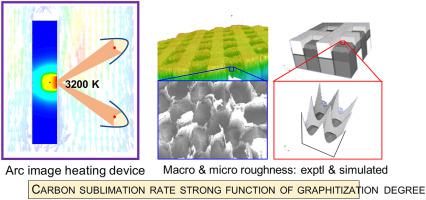Our official English website, www.x-mol.net, welcomes your
feedback! (Note: you will need to create a separate account there.)
High-flux sublimation of a 3D carbon/carbon composite: surface roughness patterns
Carbon ( IF 10.5 ) Pub Date : 2021-03-01 , DOI: 10.1016/j.carbon.2020.11.023 Cyril Levet , Jean Lachaud , Virginie Ducamp , Régis Memes , Jacques Couzi , Julien Mathiaud , Adrien P. Gillard , P. Weisbecker , Gérard L. Vignoles
Carbon ( IF 10.5 ) Pub Date : 2021-03-01 , DOI: 10.1016/j.carbon.2020.11.023 Cyril Levet , Jean Lachaud , Virginie Ducamp , Régis Memes , Jacques Couzi , Julien Mathiaud , Adrien P. Gillard , P. Weisbecker , Gérard L. Vignoles

|
Abstract 3D carbon-fibre reinforced carbon composites (3D C f / C ) are used as thermal protection systems for atmospheric re-entry, where they are exposed to strong ablation. Particularly, sublimation of the carbonaceous material plays an important role during the re entry. To study this, an arc image furnace under controlled Argon flow is used, with heat fluxes of 8MWm-2 to 10MWm-2. The furnace and the sample thermal response have been numerically simulated prior to the experiments and match in-situ temperature measurements. Scanning electron microscopy and 3D profilometry with digital optical microscopy were used in order to characterise the epi-macro-structural and the epi-micro-structural roughness of the composite surface, evidencing a faster recession of the fibres as compared to the matrix. Carbon nanotextures have been assessed by using High-Resolution Transmission Electron Microscopy and Polarised Light Optical Microscopy, showing that the matrix is more organised than the fibre. This can explain the ”inverse” behaviour under sublimation as compared to oxidation. The results have been qualitatively interpreted using numerical simulation of differential surface recession.
中文翻译:

3D 碳/碳复合材料的高通量升华:表面粗糙度图案
摘要 3D 碳纤维增强碳复合材料 (3D C f / C ) 被用作大气再入的热保护系统,在那里它们会受到强烈的烧蚀。特别是,碳质材料的升华在再进入过程中起重要作用。为了研究这一点,使用了受控氩气流下的电弧成像炉,热通量为 8MWm-2 至 10MWm-2。在实验之前已经对炉子和样品热响应进行了数值模拟,并与原位温度测量相匹配。使用扫描电子显微镜和带有数字光学显微镜的 3D 轮廓测量法来表征复合材料表面的外显宏观结构和外显微结构粗糙度,证明与基体相比,纤维的衰退更快。碳纳米结构已通过使用高分辨率透射电子显微镜和偏振光光学显微镜进行评估,表明基质比纤维更有组织。这可以解释与氧化相比在升华下的“相反”行为。使用差分表面衰退的数值模拟对结果进行了定性解释。
更新日期:2021-03-01
中文翻译:

3D 碳/碳复合材料的高通量升华:表面粗糙度图案
摘要 3D 碳纤维增强碳复合材料 (3D C f / C ) 被用作大气再入的热保护系统,在那里它们会受到强烈的烧蚀。特别是,碳质材料的升华在再进入过程中起重要作用。为了研究这一点,使用了受控氩气流下的电弧成像炉,热通量为 8MWm-2 至 10MWm-2。在实验之前已经对炉子和样品热响应进行了数值模拟,并与原位温度测量相匹配。使用扫描电子显微镜和带有数字光学显微镜的 3D 轮廓测量法来表征复合材料表面的外显宏观结构和外显微结构粗糙度,证明与基体相比,纤维的衰退更快。碳纳米结构已通过使用高分辨率透射电子显微镜和偏振光光学显微镜进行评估,表明基质比纤维更有组织。这可以解释与氧化相比在升华下的“相反”行为。使用差分表面衰退的数值模拟对结果进行了定性解释。









































 京公网安备 11010802027423号
京公网安备 11010802027423号